Posted by: Northwest Eye in General on June 7, 2025
Overview
This article emphasizes the importance of recognizing and addressing eye infection symptoms early, as we understand how concerning this can be for you. By doing so, we can help prevent serious complications, such as vision loss. It details various symptoms associated with different types of eye infections, including:
- Conjunctivitis
- Keratitis
- Endophthalmitis
We want to reassure you that timely medical intervention can significantly improve treatment outcomes, allowing you to feel more secure in your health journey.
Introduction
In the realm of eye health, we understand that recognizing symptoms in a timely manner can mean the difference between minor discomfort and serious complications. With a range of potential eye infections—from conjunctivitis to keratitis—it’s crucial to be aware of the warning signs to maintain optimal vision and overall eye health. This article explores the key symptoms associated with various eye infections, emphasizing the importance of early detection and intervention. By equipping you with expert insights and practical advice, we aim to empower you to take proactive steps in addressing your eye health concerns. Whether it’s the telltale redness of conjunctivitis or the alarming pain of endophthalmitis, knowing when to seek help can lead to better outcomes and prevent long-term damage.
Northwest Eye: Expert Insights on Eye Infection Symptoms
At Northwest Eye, we understand how concerning eye health can be. emphasize the crucial significance of early identification of eye infection symptoms. With over 50 years of dedicated service in eye care, we empower you with the knowledge necessary to identify potential issues promptly. Statistics show that timely detection can significantly impact treatment outcomes. If left unaddressed, eye infection symptoms can lead to severe complications. For instance, glaucoma, a condition that can result from untreated infections, affects 5.2% of non-Hispanic whites and a staggering 18.8% of African Americans. This highlights the need for vigilance in maintaining .
Our expert insights, grounded in extensive clinical practice, reinforce that identifying eye infection symptoms early can lead to successful patient outcomes. We want you to feel confident in your ability to recognize these signs. Case studies, such as those involving dacryocystorhinostomy for chronic dacryocystitis, illustrate the effectiveness of timely intervention in managing complex conditions. By prioritizing education and awareness, Northwest Eye ensures that you can take proactive steps toward maintaining your eye health. We are here to help you through this process.
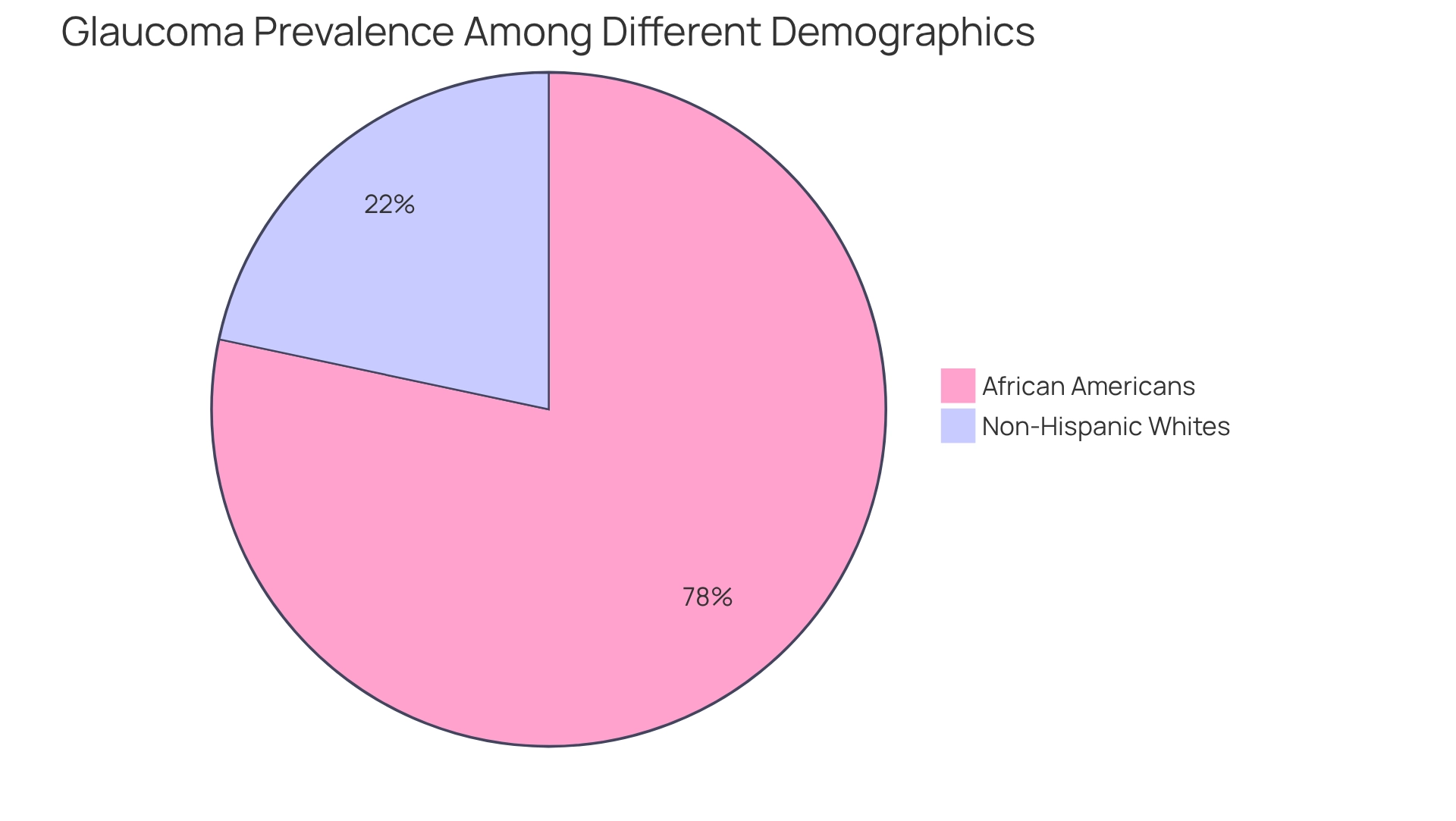
Conjunctivitis: Recognizing the Red Flags
Conjunctivitis, often known as pink eye, can significantly impact your daily life. We understand that experiencing eye infection symptoms, including redness in one or both eyes, persistent itching, a gritty sensation, and crusting discharge, can be concerning. Many patients also report eye infection symptoms that include increased tearing and swelling of the eyelids. Recognizing early is crucial, as timely intervention can prevent complications and promote effective management.
Recent studies show that a considerable number of individuals are affected by conjunctivitis, with allergic conjunctivitis being especially common during seasonal changes due to allergens such as pollen and dust. Allergic conjunctivitis typically presents with bilateral symptoms, including intense itching and watery discharge. Fortunately, these symptoms can often be alleviated by avoiding triggers and using over-the-counter antihistamine or mast cell stabilizer drops.
It’s important to distinguish between the different types of conjunctivitis—viral, bacterial, and allergic—as management strategies can vary. For instance, while viral conjunctivitis usually resolves on its own, bacterial cases may necessitate antibiotic treatment. In more severe instances, specialist management might involve corticosteroids or calcineurin inhibitors to help reduce inflammation.
At Northwest Eye, we are committed to providing comprehensive surgical services, ensuring you can schedule both urgent and elective procedures without delay. If you notice warning signs such as severe discomfort, changes in vision, or symptoms persisting beyond a week, we encourage you to consult with an eye specialist promptly. This proactive approach not only aids in accurate diagnosis but also ensures that appropriate treatment begins, enhancing your outcomes and satisfaction.
In response to COVID-19, we have implemented enhanced care protocols to prioritize your safety during your visit. By utilizing resources like the Eye Condition Library, you can gain a clearer understanding of your concerns and seek timely medical assistance. If you are experiencing eye infection symptoms such as conjunctivitis, we invite you to schedule an appointment with a Northwest Eye doctor for a thorough assessment. We are here to help you through this process.

Keratitis: Symptoms That Indicate Urgent Care
Keratitis can be quite distressing, with eye infection symptoms that include:
- Intense eye discomfort
- Redness
- Light sensitivity
- Blurred vision
- Discharge
We understand that experiencing eye infection symptoms can be alarming, especially after using contact lenses or sustaining . It’s common to feel worried in such situations, but it’s important to seek immediate medical assistance. Early intervention is crucial to prevent vision loss, and we are here to help you through this process.

Stye: Identifying Symptoms Early
A stye often appears as a red, painful bump on the eyelid, and it can be accompanied by swelling and tenderness. Many patients report feeling as though there is something in their eye. We understand that identifying these signs early is crucial. If a stye does not improve within a few days or worsens, we strongly encourage you to consult an eye care professional. Statistics suggest following up weekly for progress monitoring until the stye resolves, highlighting the importance of early intervention for better outcomes.
Real-life experiences show that early intervention, such as applying warm compresses and performing lid massages, can significantly enhance recovery. In on stye management, it was found that prompt treatment leads to quicker resolution, reducing the need for invasive procedures. Specifically, early intervention with warm compresses resulted in a notable reduction in the duration of issues and improved satisfaction among individuals.
Moreover, when individuals receiving care collaborate with healthcare providers, it enhances safety and minimizes unnecessary interventions. Ophthalmologists emphasize the importance of recognizing styes early to optimize treatment outcomes. Styes are common across various age groups, and knowing the signs and when to seek treatment can lead to better management and a more positive patient experience. We are here to help you through this process.
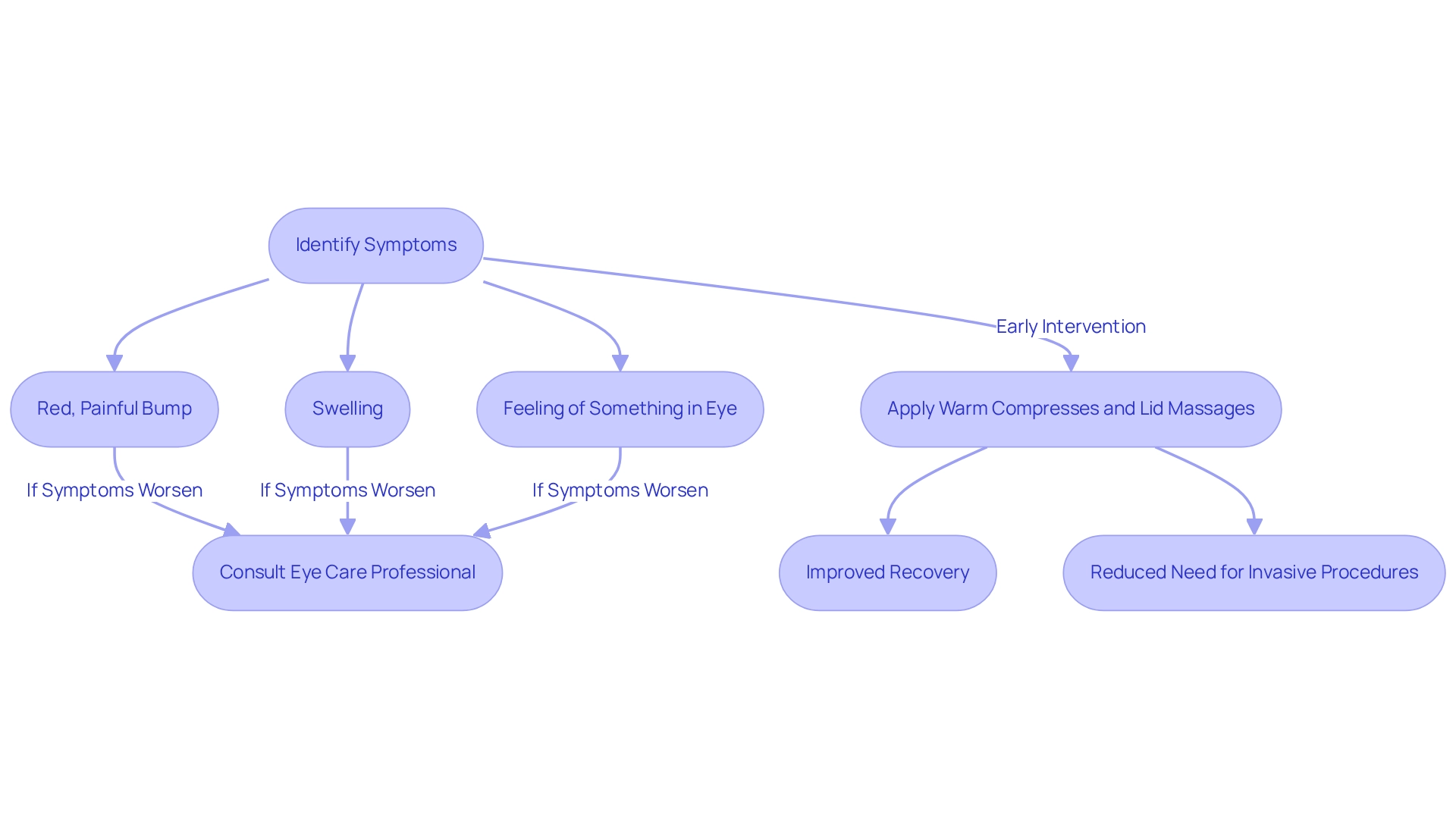
Endophthalmitis: Warning Signs of a Serious Infection
Endophthalmitis can be concerning, and it’s important to recognize the signs that require prompt attention. You may experience eye infection symptoms, including:
- Severe eye pain
- Pronounced redness
- Decreased vision
- Heightened sensitivity to light
These eye infection symptoms can be particularly alarming if they occur after eye surgery or an injury, as they may indicate a serious infection. We understand that this can be a frightening experience, but prompt medical intervention is crucial. Studies show that delayed treatment can significantly worsen outcomes, potentially leading to .
In fact, recent findings indicate that early vitrectomy can help prevent vision deterioration in many cases. Research suggests that it is less likely for vision to worsen to less than 5/200 in about 20% of cases when treated early. As Jack J. Kanski observes, ‘These treatment modalities reflect customized therapy based on disease extent, particularly in conditions like lymphoma.’ This highlights the importance of personalized attention in managing serious eye infections.
Therefore, if you notice any of these warning signs or eye infection symptoms, it is imperative to seek emergency care without delay. Remember, identifying these signs early can make a significant difference in treatment outcomes. We are here to help you through this process and ensure you receive the care you need.
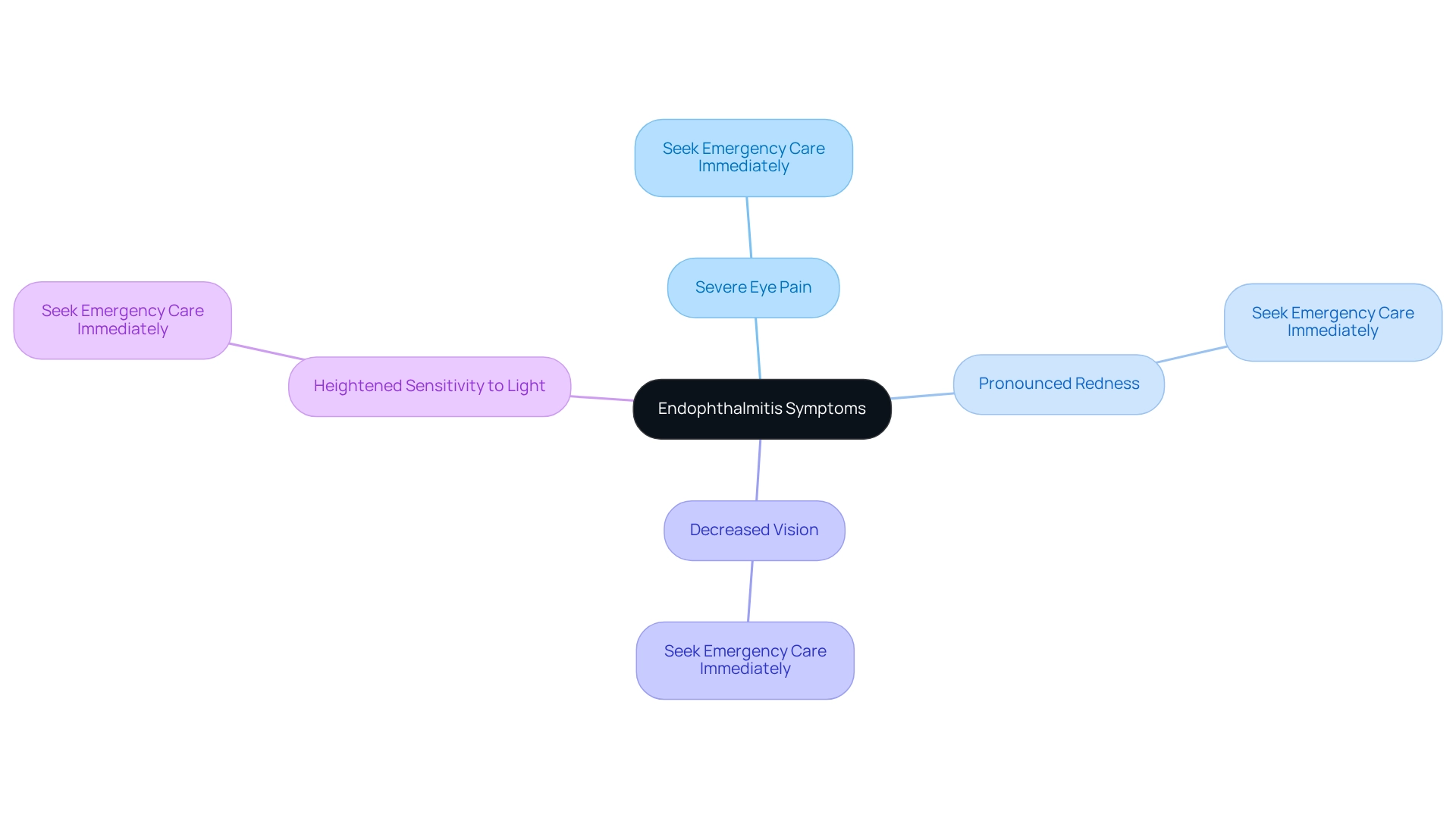
Blepharitis: Symptoms to Watch For
Blepharitis can be quite uncomfortable, and we understand that it brings several prominent signs, such as:
- Red and swollen eyelids
- A gritty sensation in the eyes
- Crusting along the eyelashes
Many patients report itching and burning feelings, which can significantly affect their quality of life. It’s important to know that managing blepharitis effectively hinges on maintaining proper eyelid cleanliness. This practice has been shown to alleviate discomfort and prevent recurrence, making it a vital part of your care.
Research highlights that regular eyelid cleaning can lead to a noticeable improvement in symptoms, underscoring the importance of this routine. Consulting an eye care professional is essential for personalized treatment options, which may include antibiotics and eye drops tailored to your needs. Recent studies emphasize the benefits of combining topical therapies with lid care, resulting in a quicker reduction in blepharitis symptoms.
For instance, identifying collarettes—tiny flakes of skin that can form at the base of the eyelashes—during routine examinations has been recognized as an effective diagnostic tool. This allows for timely intervention and better management of your condition.
Blepharitis can affect individuals of all ages, but it is particularly common among those over 50. This fact highlights the importance of awareness and proactive management strategies. By recognizing the eye infection symptoms early and implementing , you can significantly lessen the impact of this condition on your daily life. If you are experiencing signs of blepharitis or any other eye concerns, we encourage you to schedule a consultation with a Northwest Eye physician for a thorough eye assessment. We are here to help you through this process.

Uveitis: Key Symptoms You Shouldn’t Overlook
Uveitis can manifest with several key signs that require your prompt attention. Common indicators of eye infection symptoms are eye pain, redness, blurred vision, and heightened sensitivity to light. These signs can appear suddenly and may indicate a serious underlying condition. We understand that seeking medical evaluation is crucial to prevent potential complications, such as vision loss or chronic eye issues.
Statistics reveal that the incidence of noninfectious uveitis (NIU) is significant, with an estimated 3,023 pediatric cases reported (95% CI, 2,151-4,154). Understanding the demographics of uveitis is essential, as the prevalence tends to increase with age and is notably higher among adult females, as noted by , MD, PhD. This highlights the importance of awareness and timely intervention.
Experts emphasize the importance of addressing uveitis indicators promptly. Ophthalmologists stress that untreated uveitis can lead to severe complications, including glaucoma and retinal damage. Common triggers for uveitis, such as autoimmune disorders and infections, complicate the condition, making it essential for individuals to recognize eye infection symptoms early.
In real-life situations, individuals experiencing uveitis signs have benefited from immediate assistance efforts focusing on managing issues and treatment approaches. While complementary therapies may offer relief, they should not replace traditional medical treatment. Seeking advice from healthcare experts is crucial for anyone encountering these signs to ensure appropriate care and prevent lasting effects. Positive feedback from individuals reflects Northwest Eye‘s reputation for excellence in eye care, reinforcing the significance of seeking timely medical attention.
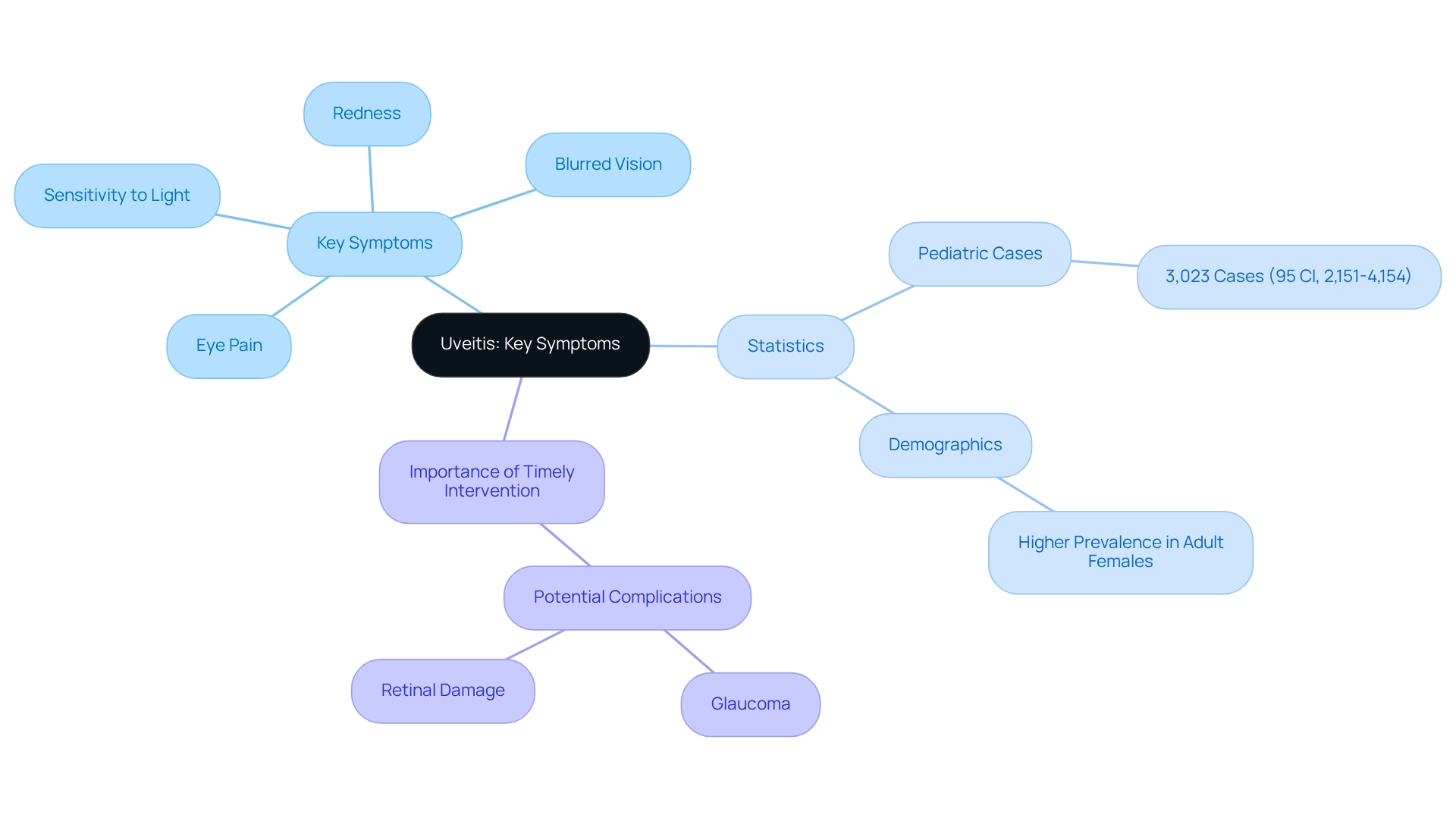
Ocular Herpes: Symptoms That Require Prompt Action
Ocular herpes manifests with several critical indications that require prompt medical attention. We understand that experiencing eye infection symptoms, such as redness, pain, excessive tearing, and heightened sensitivity to light, can be alarming. Patients may also observe blisters forming around the eyelids, which can be particularly concerning. Prompt action is essential, as can lead to severe complications, including potential vision loss. Prophylaxis for individuals with a history of HSV is crucial; it necessitates at least 400 mg of acyclovir two or more times daily to avert complications, especially prior to any eye surgery, as highlighted by Dr. Chodosh.
The occurrence of ocular herpes is considerable, impacting millions worldwide, with many people unaware of their condition until signs appear. Dr. Margolis emphasizes that if substantial improvement is not observed in cases of keratitis, a referral to a specialist is crucial to prevent further complications. We recognize that this can be a stressful time, but seeking help is a vital step in your care journey.
Education about ocular herpes is vital for effective management. For example, early identification can greatly enhance outcomes for individuals, as shown in a case study emphasizing the significance of precise diagnosis in unilateral conjunctivitis. In this case, unilateral follicular conjunctivitis was found to indicate HSV rather than typical conjunctivitis, underscoring the necessity of culturing the eye for confirmation.
Statistics reveal that complications from untreated ocular herpes can be severe, reinforcing the need for awareness and prompt action. Individuals facing signs should not hesitate to seek urgent care, as prompt action can reduce risks and improve recovery. Understanding these signs and their implications helps patients effectively manage their eye health, especially in relation to eye infection symptoms. Remember, we are here to help you through this process.
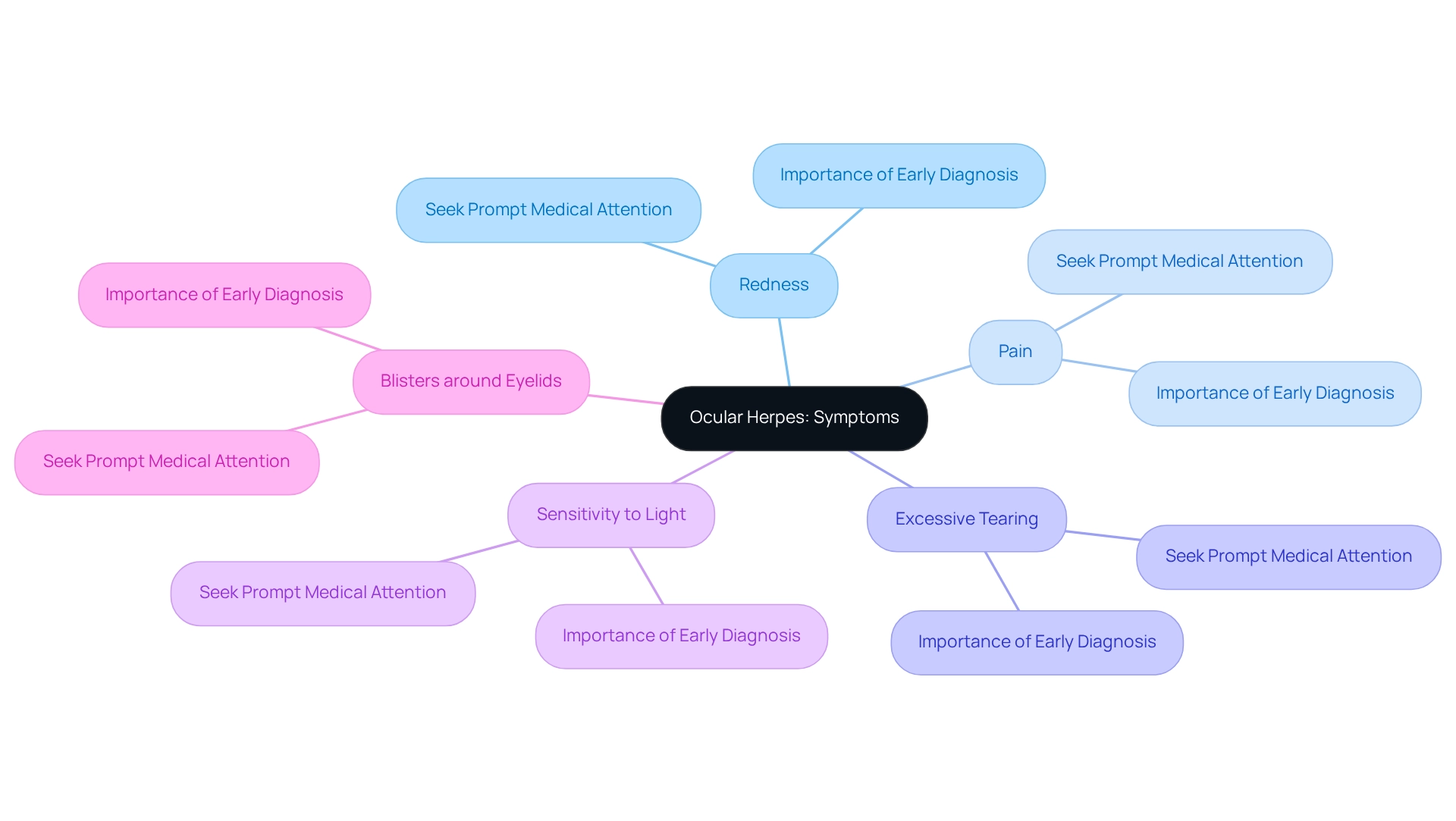
Allergic Conjunctivitis: Symptoms and Differentiation
Allergic conjunctivitis can be quite distressing, often exhibiting eye infection symptoms like intense itching, redness, and watery discharge. Unlike bacterial conjunctivitis, which produces thick, purulent discharge, allergic conjunctivitis typically does not involve such secretions. Common allergens, such as pollen, dust mites, and pet dander, can provoke these reactions, significantly impacting daily life for those affected. We understand how challenging this can be, and or eye specialist is highly recommended for effective management, especially if symptoms persist.
To help distinguish allergic conjunctivitis from its bacterial counterpart, consider the nature of the discharge and accompanying signs. Allergic conjunctivitis is frequently associated with other allergic reactions, such as sneezing or nasal congestion. In contrast, bacterial conjunctivitis may present additional eye infection symptoms, including fever or swollen lymph nodes.
Statistics indicate that allergic conjunctivitis affects a substantial portion of the population, with prevalence rates rising due to increased exposure to allergens. Effective management strategies include:
- Avoiding known triggers
- Using antihistamines to alleviate discomfort
By understanding these differences and management methods, patients can navigate their challenges more effectively and pursue prompt assistance. Remember, we are here to help you through this process.
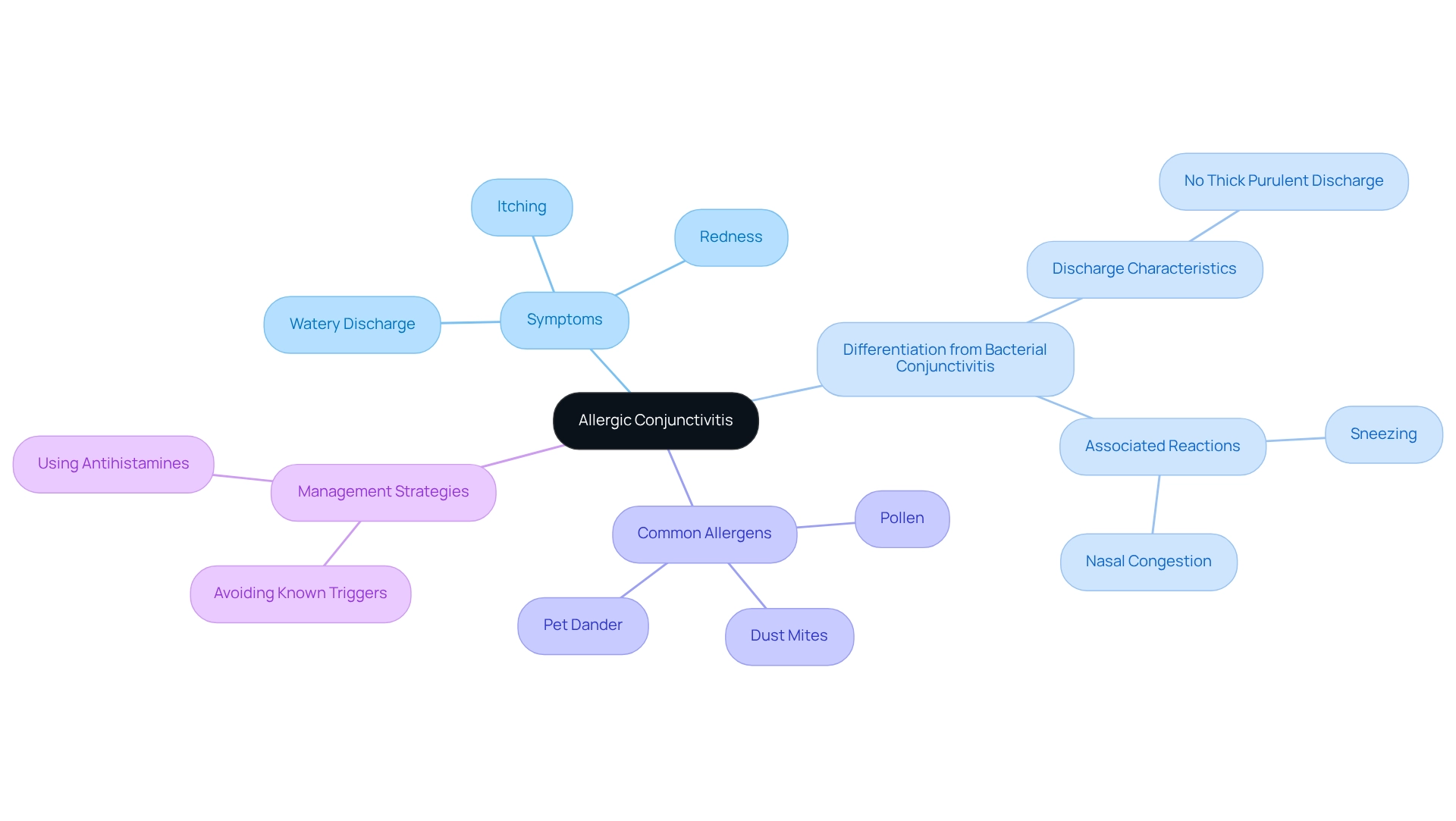
General Symptoms of Eye Infections: What to Look For
We understand that noticing changes in your eyes can be concerning. Typical eye infection symptoms include:
- Redness
- Swelling
- Pain
- Discharge
- [Sensitivity to light](https://resources.healthgrades.com/right-care/eye-health/eye-infection)
You might also experience blurred vision and a gritty sensation. It’s common to feel anxious when facing these symptoms, but we want to reassure you that seeking help is the best step forward. If you notice any of these eye infection symptoms, it is important to consult professional for an accurate diagnosis and appropriate treatment. Remember, you are not alone in this; we are here to help you through this process.
Conclusion
Recognizing the symptoms of eye infections is vital for maintaining optimal eye health and preventing potential complications. We understand that noticing changes in your eyes can be concerning, and this article highlights the key indicators associated with various eye infections, such as:
- Conjunctivitis
- Keratitis
- Styes
- Endophthalmitis
- Blepharitis
- Uveitis
- Ocular herpes
- Allergic conjunctivitis
Each condition presents specific symptoms—ranging from redness and discharge to severe pain and vision changes—that require prompt attention.
The importance of early detection cannot be overstated. It’s common to feel anxious about your eye health, but timely intervention can lead to better treatment outcomes and significantly reduce the risk of long-term damage. Whether it’s managing the discomfort of conjunctivitis or addressing the serious implications of endophthalmitis, being proactive about eye health is essential. We encourage you to seek medical advice when experiencing any concerning symptoms, as expert insights and tailored treatments can make a substantial difference in your recovery.
Ultimately, awareness and education about eye infections empower individuals to take charge of their eye health. By understanding the warning signs and knowing when to consult a professional, you can ensure you receive the appropriate care needed to protect your vision and overall well-being. Prioritizing eye health today lays the foundation for a brighter, clearer tomorrow. Remember, we are here to help you through this process.
Frequently Asked Questions
What is the importance of early identification of eye infection symptoms?
Early identification of eye infection symptoms is crucial as it can significantly impact treatment outcomes. Timely detection helps prevent severe complications, such as glaucoma.
What are the common symptoms of conjunctivitis?
Common symptoms of conjunctivitis include redness in one or both eyes, persistent itching, a gritty sensation, crusting discharge, increased tearing, and swelling of the eyelids.
How can allergic conjunctivitis be managed?
Allergic conjunctivitis can often be managed by avoiding allergens and using over-the-counter antihistamine or mast cell stabilizer drops.
What distinguishes the different types of conjunctivitis?
The different types of conjunctivitis—viral, bacterial, and allergic—are distinguished by their symptoms and management strategies. Viral conjunctivitis usually resolves on its own, while bacterial cases may require antibiotic treatment.
What symptoms indicate the need for urgent care in keratitis?
Symptoms indicating the need for urgent care in keratitis include intense eye discomfort, redness, light sensitivity, blurred vision, and discharge.
What should I do if I experience severe discomfort or changes in vision?
If you experience severe discomfort, changes in vision, or symptoms persisting beyond a week, it is important to consult with an eye specialist promptly for accurate diagnosis and treatment.
How has Northwest Eye adapted its services in response to COVID-19?
Northwest Eye has implemented enhanced care protocols to prioritize patient safety during visits, ensuring both urgent and elective procedures can be scheduled without delay.
Where can I find more information about eye conditions?
You can gain a clearer understanding of your concerns and seek timely medical assistance by utilizing resources like the Eye Condition Library provided by Northwest Eye.






